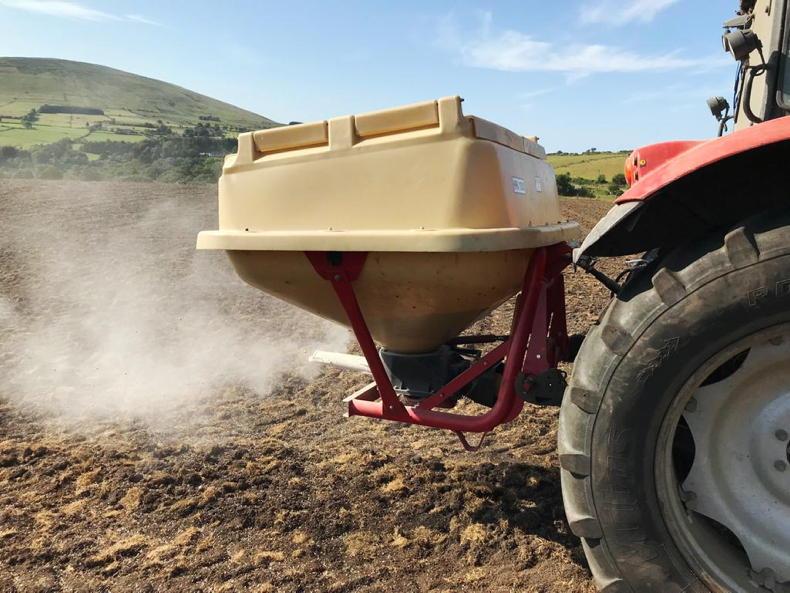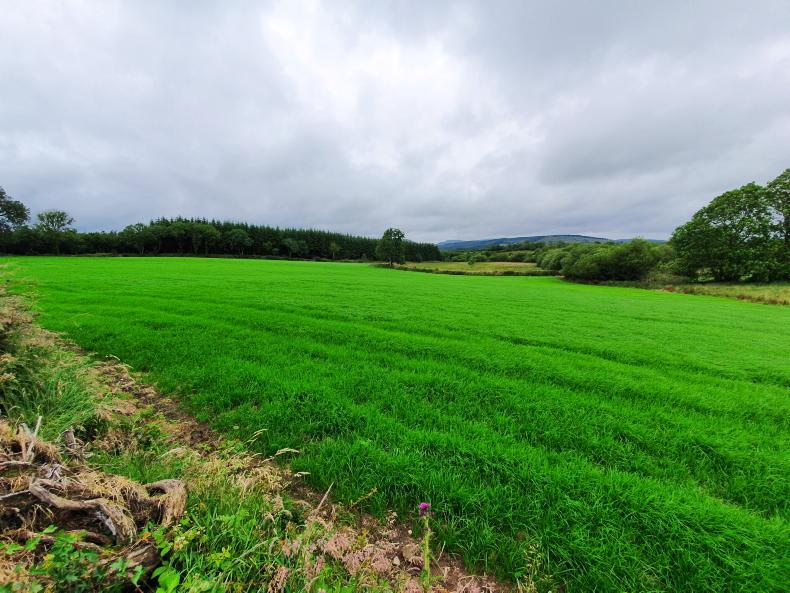Good weather and good cattle prices over the past few weeks have meant that some beef farmers are looking at the opportunity to reseed some of their farm this spring.
Traditionally, beef farmers have opted for an autumn reseed as there is big pressure on grazing ground on most farms in spring, but a springtime reseed can be back in for grazing in six to eight weeks if planned and completed correctly.

Six acres of silage ground was reseeded by Dermot, starting when the old sward was burned off on 12 June. ground was rotavated and power harrowed twice with grass seed drilled on 10 July.
April and May are two of the best months to reseed to avoid drought issues later on in summer. There has been a lot of talk in recent times about the role white clover can play in meeting our target reduction in agricultural emissions by 2030.
Teagasc research would suggest that, on many farms, white clover can deliver sufficient nitrogen to a grass plant to grow similar quantities of grass where nitrogen is applied. This is especially relevant for lower-stocked beef farms which could potentially reduce costs through reduced nitrogen application and rely on clover swards to fix the nitrogen from the atmosphere to feed the grass sward on the farm.

Reseeding.
Clover swards also have other advantages like higher digestibility, so in theory animals grazing clover swards should put on weight faster. There are also challenges with clover swards and they require a higher level of management at certain times of the year.
Soil fertility
I have seen lots of reseeding projects fail over the years with farmers blaming the contractor, the grass seed, the fertiliser and the weather when in fact the problem was that soil fertility wasn’t correct.
For reseeding to be a success, soil fertility has to be right and in many cases you would be better to correct soil fertility and forget about reseeding until soil fertility is corrected. Soil sampling is the only definitive way of analysing soil fertility levels and you are looking for phosphorus (P) and potassium (K) levels in the soil to be at index 3.
The pH of the soil also needs to be above 6.3 for a successful reseed. Where soil fertility is below where it needs to be, you will need to spread 2-3 bags/ac of 10-10-20 or other P and K-rich fertiliser to kick-start early growth and make sure the new seed becomes established.
Lime should also be applied pre-sowing to improve soil structure.
Seedbed preparation
With regard to the field that is being reseeded, farmers should be aiming for it to be out of production for 60-70 days maximum. If the old sward is being sprayed off, you can move in to plough or cultivate seven to 10 days after spraying. Some farmers will even move in quicker than this.
If you are using minimum cultivation methods, make sure that any remaining grass on the paddock/field has been topped or grazed off tight prior to stitching in the new grass.
Sowing
The general sequence of a plough, till and sow is ploughing, then power harrow to leave a fine, firm, level seedbed. Some fields may require two runs of a power harrow and some land levelling, depending on the topography of the field.
It’s very important to get the seedbed right prior to sowing. If the seedbed is too fluffy and soft the seed may go too deep and run the risk of failing. In some instances, it may be required to roll the field prior to sowing and then roll again after seeding to make sure the seed makes good contact with the soil.
If direct drilling or stitching, some contractors recommend an additional run over the field in a diagonal direction making sure all the field is covered. Seed should be sowed at the rate of 14kg/acre.
Grass seed selection
When it comes to selecting grass seed varieties, you should look at your system and what you want the grass to do for you, eg is it silage or grazing or both, and then choose your grass seed mix. Only use varieties on the Irish recommended grass seed list. Most grass seed mixtures contain a mix of diploid and tetraploid varieties. There are benefits to each type. Table 1 outlines some of the differences between diploids and tetraploids.
Heading dates are also important and a tight range (seven to 10 days) is advisable to aid in management of the new reseed. Early heading grass varieties will head out in early May while intermediate varieties will head out in the second half of May.
Late-heading varieties will head out in the first half of June and are more suited to wetter soil types. Clover should also be included in grazing mixes at a recommended rate of 2kg/ac.
Post-sowing management
Post-sowing management is almost as important at the reseeding process itself. Once the reseeding process is finished you should check in on the reseed at regular weekly intervals to monitor for germination and weeds.
A post-emergence spray should be applied six to eight weeks after reseeding to kill any broadleaved weeds that emerge in the new reseed. Weeds are best controlled when the grass plant is at the three-leaf stage. White cloversafe herbicide should be used. An application of nitrogen at this stage will also help feed the new grass.
In short
Soil fertility is very important for a successful reseed.Choose grass varieties from the recommended list to suit your system.Diploid grasses will suit heavier soil types better.A post emergence spray should be applied 6-8 weeks after the new grass seed emerges to control seedling docks and other weeds.Try to graze the sward with light weanling sheep for first grazing and avoid cutting in first few months.
Good weather and good cattle prices over the past few weeks have meant that some beef farmers are looking at the opportunity to reseed some of their farm this spring.
Traditionally, beef farmers have opted for an autumn reseed as there is big pressure on grazing ground on most farms in spring, but a springtime reseed can be back in for grazing in six to eight weeks if planned and completed correctly.

Six acres of silage ground was reseeded by Dermot, starting when the old sward was burned off on 12 June. ground was rotavated and power harrowed twice with grass seed drilled on 10 July.
April and May are two of the best months to reseed to avoid drought issues later on in summer. There has been a lot of talk in recent times about the role white clover can play in meeting our target reduction in agricultural emissions by 2030.
Teagasc research would suggest that, on many farms, white clover can deliver sufficient nitrogen to a grass plant to grow similar quantities of grass where nitrogen is applied. This is especially relevant for lower-stocked beef farms which could potentially reduce costs through reduced nitrogen application and rely on clover swards to fix the nitrogen from the atmosphere to feed the grass sward on the farm.

Reseeding.
Clover swards also have other advantages like higher digestibility, so in theory animals grazing clover swards should put on weight faster. There are also challenges with clover swards and they require a higher level of management at certain times of the year.
Soil fertility
I have seen lots of reseeding projects fail over the years with farmers blaming the contractor, the grass seed, the fertiliser and the weather when in fact the problem was that soil fertility wasn’t correct.
For reseeding to be a success, soil fertility has to be right and in many cases you would be better to correct soil fertility and forget about reseeding until soil fertility is corrected. Soil sampling is the only definitive way of analysing soil fertility levels and you are looking for phosphorus (P) and potassium (K) levels in the soil to be at index 3.
The pH of the soil also needs to be above 6.3 for a successful reseed. Where soil fertility is below where it needs to be, you will need to spread 2-3 bags/ac of 10-10-20 or other P and K-rich fertiliser to kick-start early growth and make sure the new seed becomes established.
Lime should also be applied pre-sowing to improve soil structure.
Seedbed preparation
With regard to the field that is being reseeded, farmers should be aiming for it to be out of production for 60-70 days maximum. If the old sward is being sprayed off, you can move in to plough or cultivate seven to 10 days after spraying. Some farmers will even move in quicker than this.
If you are using minimum cultivation methods, make sure that any remaining grass on the paddock/field has been topped or grazed off tight prior to stitching in the new grass.
Sowing
The general sequence of a plough, till and sow is ploughing, then power harrow to leave a fine, firm, level seedbed. Some fields may require two runs of a power harrow and some land levelling, depending on the topography of the field.
It’s very important to get the seedbed right prior to sowing. If the seedbed is too fluffy and soft the seed may go too deep and run the risk of failing. In some instances, it may be required to roll the field prior to sowing and then roll again after seeding to make sure the seed makes good contact with the soil.
If direct drilling or stitching, some contractors recommend an additional run over the field in a diagonal direction making sure all the field is covered. Seed should be sowed at the rate of 14kg/acre.
Grass seed selection
When it comes to selecting grass seed varieties, you should look at your system and what you want the grass to do for you, eg is it silage or grazing or both, and then choose your grass seed mix. Only use varieties on the Irish recommended grass seed list. Most grass seed mixtures contain a mix of diploid and tetraploid varieties. There are benefits to each type. Table 1 outlines some of the differences between diploids and tetraploids.
Heading dates are also important and a tight range (seven to 10 days) is advisable to aid in management of the new reseed. Early heading grass varieties will head out in early May while intermediate varieties will head out in the second half of May.
Late-heading varieties will head out in the first half of June and are more suited to wetter soil types. Clover should also be included in grazing mixes at a recommended rate of 2kg/ac.
Post-sowing management
Post-sowing management is almost as important at the reseeding process itself. Once the reseeding process is finished you should check in on the reseed at regular weekly intervals to monitor for germination and weeds.
A post-emergence spray should be applied six to eight weeks after reseeding to kill any broadleaved weeds that emerge in the new reseed. Weeds are best controlled when the grass plant is at the three-leaf stage. White cloversafe herbicide should be used. An application of nitrogen at this stage will also help feed the new grass.
In short
Soil fertility is very important for a successful reseed.Choose grass varieties from the recommended list to suit your system.Diploid grasses will suit heavier soil types better.A post emergence spray should be applied 6-8 weeks after the new grass seed emerges to control seedling docks and other weeds.Try to graze the sward with light weanling sheep for first grazing and avoid cutting in first few months. 







 This is a subscriber-only article
This is a subscriber-only article










SHARING OPTIONS: